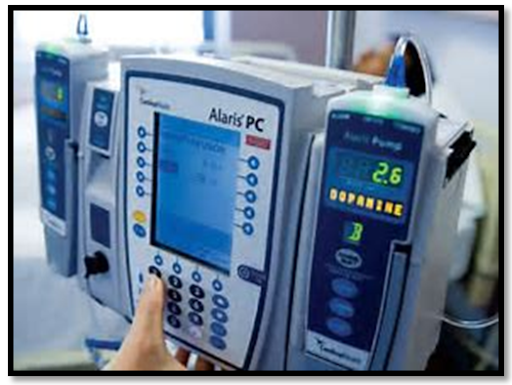Journey to the ICU- Line(s) up! Get Ready!
Author: Miki Shibata, MS, CCC-SLP
Edited By: Ainsley Martin, MS, CCC-SLP
As a Speech Language Pathologist working in acute care, my number one rule is: DON’T MESS UP OTHER TEAMS’ PLANS OF CARE. In the ICU, this means knowing your way around medical equipment, upcoming procedures, and general goals of care for the patient. In this installment of Journey to the ICU, I’ll introduce some of the most common lines that we encounter, and necessary precautions you may need to take with your patients.
Peripheral IV
"IV” Attribution to Scoobyfoo
Image Source
IV Pump
"IV Pump" Attribution to Hanan Mohammed Mohammed Image Source
Peripheral IV, IV Pump
Purpose: Infuse fluids, blood products, medications, nutritional supplements
Location/Site: Distal extremities, particularly the upper extremity (arms, hands). With peripheral IVs, there is an increased risk of thrombosis/thrombophlebitis (process in which a blood clot forms in the superficial veins causing swelling and pain).
Precautions:
When moving pt, make sure to move infusion pole and give yourself enough slack.
Know some common IV medications that need immediate attention when infusion is complete or if the line is kinked (insulin, heparin, sedatives, intropes, vasopressors). Inform RN if the pump starts to beep.
If line is accidentally removed stop infusion. If the site is bleeding, hold clean gauze/towel and call the RN
Patient Controlled Analgesia (PCA)
“Patient Controlled Analgesic device” Attribution to Neeta Lind
Image Source
Patient Controlled Analgesia (PCA)
Purpose: Used to treat moderate to severe postoperative pain by dispensing a pre-calculated dose of pain medication at appropriate timing. The patient activates the infusion pump by usually pushing a button.
Location/Site:
Distal extremities, particularly the upper extremity (arms, hands). There is an increased risk of thrombosis/thrombophlebitis (process in which a blood clot forms in the superficial veins causing swelling and pain) when placed in lower extremities.
Precautions:
As with all pain control medications, if pt seems unresponsive to even noxious stimuli (sternal rub, nail bed stimulation) alert the RN.
Be careful and time your sessions well, as pts often are lethargic after a dose and may not be alert enough for your evaluation.
Central Venous Catheter
“Triple-Lumen” Attribution to Silie
Image Source
Central Venous Catheter
Purpose: Line placed in a large vein, in which the lines empty out near or in the heart, used to provide fluids, medications, and to draw blood for testing. These types of lines can be kept in the body for a longer period of time compared to peripheral lines, for example.
Location/Site:
Subclavian, femoral, brachial, jugular placements
Precautions: Many of these lines are surgically placed (including some under interventional radiology) and it is a BIG DEAL. If a line comes out, immediately alert the RN and place pressure on the site with clean gauze, towel, or linen.
Types: There are a few types of central venous catheters- differentiated by purpose, placement, type of insertion (peripheral/central),number of lumens, implanted or not (and to what degree- tunneled, totally implanted)
Peripherally Inserted Central Catheter (PICC) - Inserted from a peripheral vein in the arm to a larger vein closer to the heart, for IV medications, particularly ones that may be irritating to smaller peripheral veins, IV nutrition - TPN
PICC Line
“PICC Line” Attribution to Simon Lee
Image Source
Hickman Line - Hemodialysis, medication delivery, chemotherapy, IV nutrition
Hickman Line
“A Hickman line two-lumen catheter inserted on the patient's left side. Scars at the base of the neck indicate the insertion point into the left jugular vein.” Attribution to General Judd
Arterial Line/A-Line - Placement of catheter inside an artery to continuously monitor blood pressure and allow for arterial blood sampling
-Location/Site: Most commonly radial or femoral, but also seen in axillary or pedal
-Precautions: These lines are extremely sensitive to movement, so take care to clear any changes to patient positioning with RN. For example, many patients with femoral arterial lines cannot be sat up past a certain point because it will throw off the read. Additionally some very critical patients can have multiple arterial lines.
(Pierre & Keenaghan, 2018)
“Arterial Kateter” Attribution to: Privatarchiv Foto von MrArifnajafov
Pulmonary Artery Catheter (PAC)
“Pulmonary artery catheter”
Attribution to: Tariq Abdulla
Image Source
“Pulmonary Artery Catheter”
Attribution to: ICUnurses
Image Source
The PAC also falls within the category of the Centeral Venous Catheters or lines, but it deserves it's own spot because it's pretty complicated. PACs are done as a diagnostic procedure in which a intravascular catheter is inserted through a central vein (femoral, jugular, antecubital or brachial), toward the right side of heart, and advanced to the pulmonary artery.
Purpose: Assess right sided cardiac chamber filling pressures, estimation of cardiac output, intracardiac shunt (Diversion of of normal cardiac flow to alternate pathways of the heart. Caused by holes in structures that are supposed to separate arterial and venous - this can lead to low O2 levels, decompression illness, and strokes, as well as pulmonary hypertension, arrhythmias, and heart failure) evaluation (National Jewish Health, 2014), valvular (heart valves such as tricuspid, mitral, pulmonary, aortic) studies, and vascular resistance (resistance in circulatory system that is used to create blood pressure), when balloon at end of catheter is inflated, indirect assessment of left sided filling pressures via pulmonary capillary wedge pressure
Frequently seen/Indications: Patients with pulmonary hypertension, cardiogenic shock, and unexplained dyspnea
Equipment: Swan-Ganz Catheter, also called Right Heart Catheter a four lumen catheter that is used to draw blood, provide medication, and monitoring (central venous pressure, right atrial pressure, pulmonary artery pressure)
(Rodriguez Ziccardi, et al., 2019).
References:
Pierre L, Keenaghan M. Arterial Lines. [Updated 2018 Dec 13]. In: StatPearls [Internet]. Treasure Island (FL): StatPearls Publishing; 2019 Jan-. Available from: https://www.ncbi.nlm.nih.gov/books/NBK499989/
Memorial Sloan Kettering Cancer Center. (2018, August 15). About your Implanted Port. Retrieved from https://www.mskcc.org/cancer-care/patient-education/your-implanted-port
National Jewish Health. (2014). Intracardiac Shunts. Retrieved June 9, 2019, from https://www.nationaljewish.org/NJH/media/pdf/MF-Intracardiac-Shunt.pdf?ext=.pdf
Rodriguez Ziccardi M, Khalid N. Pulmonary Artery Catheterization. [Updated 2019 Feb 16]. In: StatPearls [Internet]. Treasure Island (FL): StatPearls Publishing; 2019 Jan-.Available from: https://www.ncbi.nlm.nih.gov/books/NBK482170/
Additional Resources:
https://www.cdc.gov/hai/bsi/catheter_faqs.html
https://www.uptodate.com/contents/overview-of-central-venous-access









